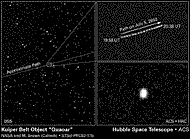|
COMETS EARTH JUPITER KUIPER BELT MARS MERCURY METEORITES NEPTUNE OORT CLOUD PLUTO SATURN SOLAR SYSTEM SPACE SUN URANUS VENUS ORDER PRINTS
PHOTO CATEGORIES SCIENCEVIEWS AMERICAN INDIAN AMPHIBIANS BIRDS BUGS FINE ART FOSSILS THE ISLANDS HISTORICAL PHOTOS MAMMALS OTHER PARKS PLANTS RELIGIOUS REPTILES SCIENCEVIEWS PRINTS
|
Related Documents
Download Options
With the help of NASA's Hubble Space Telescope, astronomers have determined that 2002 LM60, an icy Kuiper belt object dubbed "Quaoar," by its discoverers, is the largest body found in the solar system since the discovery of Pluto 72 years ago. Quaoar (pronounced kwa-whar) is about half the size of Pluto. Like Pluto, Quaoar dwells in the Kuiper belt, an icy debris field of comet-like bodies extending 7 billion miles beyond Neptune's orbit. The photograph at bottom right, taken by Hubble's Advanced Camera for Surveys, is a close-up view of the icy world. Only Hubble's sharp vision can resolve the disk of this distant world, leading to the first-ever direct measurement of the true size of a Kuiper belt object. Quaoar's diameter is about 800 miles (1300 kilometers). It is the farthest object in the solar system ever to be resolved by a telescope. The Hubble photo does not show details of Quaoar's icy surface because the object is too far away. Quaoar is about 4 billion miles (6.5 billion kilometers) from Earth, more than 1 billion miles farther than Pluto. The photograph was made by assembling 16 pictures of the object. Observations were made July 5, 2002 and Aug. 1, 2002. The image at upper right is a composite of 16 snapshots of the object as it traveled across the sky. Quaoar is in a circular orbit around the Sun. The snapshots were taken over a 29- minute span on July 5. The photograph at left, part of the Digitized Sky Survey, shows the Kuiper belt object's approximate path across the summer constellation Ophiuchus. The small box in the center defines Hubble's narrow view, an area devoid of stars. |
